Abstract
Additive manufacturing (AM) technologies such as fused deposition modeling (FDM) have been widely used in various fields of today’s manufacturing industries such as transportation, aerospace, and medical because of its ability to produce parts of complex designs with less manufacturing time and cost. However, a proper selection of input process parameters is a vital aspect in order to obtain the best quality of the printed part. This paper presents several approaches, namely response surface methodology, particle swarm optimization, and symbiotic organism search, to find the optimal parameter settings for better surface quality, i.e., surface roughness of the FDM printed part. Layer height, print speed, print temperature, and outer shell speed were considered as the input parameters and surface roughness as the output response. The experimental design was carried out using response surface methodology (RSM) method. Then, the relationship between the input parameters and the surface roughness was established using regression model. Once the accuracy of the model had been validated, the model was then coupled with particle swarm optimization (PSO) and symbiotic organism search (SOS) to optimize the input parameters that would lead to minimum surface roughness. Experimental results showed that the surface roughness obtained using PSO and SOS have improved about 8.5% and 8.8%, respectively, compared with the conventional method, i.e., RSM. A good agreement between the predicted surface roughness and the experimental values was also observed.












Similar content being viewed by others
References
Yan Q, Dong H, Su J, Han J, Song B, Wei Q, Shi Y (2018) A review of 3D printing technology for medical applications. Engineering 4(5):729–742. https://doi.org/10.1016/j.eng.2018.07.021
Singamneni S, Yifan L, Hewitt A, Chalk R, Thomas W (2019) Additive manufacturing for the aircraft industry: a review. J Aeronaut Aerospace Eng 8(214):2
Deswal S, Narang R, Chhabra D (2019) Modeling and parametric optimization of FDM 3D printing process using hybrid techniques for enhancing dimensional preciseness. Int J Interact Des Manuf (IJIDeM):1-18
Lyu J, Manoochehri S (2019) Multi-objective optimization based on machine reliability and process-dependent product quality for FDM system. Int J Adv Manuf Technol:1-10
Griffiths C, Howarth J, De Almeida-Rowbotham G, Rees A, Kerton R (2016) A design of experiments approach for the optimisation of energy and waste during the production of parts manufactured by 3D printing. J Clean Prod 139:74–85
Boursier J-F, Fournet A, Bassanino J, Manassero M, Bedu A-S, Leperlier D (2018) Reproducibility, accuracy and effect of autoclave sterilization on a thermoplastic three-dimensional model printed by a desktop fused deposition modelling three-dimensional printer. Vet Comp Orthopaed Traumatol 31(06):422–430
Leite M, Varanda A, Ribeiro AR, Silva A, Vaz MF (2018) Mechanical properties and water absorption of surface modified ABS 3D printed by fused deposition modelling. Rapid Prototyp J 24(1):195–203
Srivastava M, Rathee S, Maheshwari S, Kundra T (2019) Estimating percentage contribution of process parameters towards build time of FDM process for components displaying spatial symmetry: a case study. Int J Mater Prod Technol 58(2-3):201–224
Mohamed OA, Masood SH, Bhowmik JL (2015) Optimization of fused deposition modeling process parameters: a review of current research and future prospects. Adv Manuf 3(1):42–53
Boér J, Blaga P (2018) Reducing production costs by monitoring the roughness of raw product surfaces. Procedia Manuf 22:202–208. https://doi.org/10.1016/j.promfg.2018.03.031
Alsoufi MS, Elsayed AE (2018) Surface roughness quality and dimensional accuracy-a comprehensive analysis of 100% infill printed parts fabricated by a personal/desktop cost-effective FDM 3D printer. Mater Sci Appl 9:11–40
Peng T, Yan F (2018) Dual-objective analysis for desktop FDM printers: energy consumption and surface roughness. Procedia CIRP 69:106–111
Anitha R, Arunachalam S, Radhakrishnan P (2001) Critical parameters influencing the quality of prototypes in fused deposition modelling. J Mater Process Technol 118(1):385–388. https://doi.org/10.1016/S0924-0136(01)00980-3
Reddy V, Flys O, Chaparala A, Berrimi CE, Amogh V, Rosén BG (2018) Study on surface texture of Fused Deposition Modeling. Procedia Manuf 25:389–396
Nancharaiah T, Raju DR, Raju VR (2010) An experimental investigation on surface quality and dimensional accuracy of FDM components. Int J Emerg Technol 1(2):106–111
Horvath D, Noorani R, Mendelson M Improvement of surface roughness on ABS 400 polymer using design of experiments (DOE). In: Materials Science Forum, 2007. Trans Tech Publ, pp 2389-2392
Chung Wang C, Lin T-W, Hu S-S (2007) Optimizing the rapid prototyping process by integrating the Taguchi method with the Gray relational analysis. Rapid Prototyp J 13(5):304–315
Jiang R, Kleer R, Piller FT (2017) Predicting the future of additive manufacturing: A Delphi study on economic and societal implications of 3D printing for 2030. Technol Forecast Soc 117:84–97
Thrimurthulu K, Pandey PM, Venkata Reddy N (2004) Optimum part deposition orientation in fused deposition modeling. Int J Mach Tool Manuf 44(6):585–594. https://doi.org/10.1016/j.ijmachtools.2003.12.004
Asadollahi-Yazdi E, Gardan J, Lafon P (2018) Multi-objective optimization of additive manufacturing process. IFAC-PapersOnLine 51(11):152–157. https://doi.org/10.1016/j.ifacol.2018.08.250
Rao RV, Rai DP (2016) Optimization of fused deposition modeling process using teaching-learning-based optimization algorithm. Eng Sci Technol Int J 19(1):587–603
Pandey PM, Thrimurthulu K, Reddy* NV (2004) Optimal part deposition orientation in FDM by using a multicriteria genetic algorithm. Int J Prod Res 42(19):4069–4089
Byun HS, Lee* KH (2005) Determination of the optimal part orientation in layered manufacturing using a genetic algorithm. Int J Prod Res 43(13):2709–2724. https://doi.org/10.1080/00207540500031857
Khatir S, Wahab MA, Benaissa B, Köppen M Crack identification using eXtended IsoGeometric analysis and particle swarm optimization. In: Fracture, fatigue and wear, 2018. Springer, pp 210-222
Prasad D, Mukherjee V (2016) A novel symbiotic organisms search algorithm for optimal power flow of power system with FACTS devices. Eng Sci Technol Int J 19(1):79–89
Tran D-H, Cheng M-Y, Prayogo D (2016) A novel Multiple Objective Symbiotic Organisms Search (MOSOS) for time–cost–labor utilization tradeoff problem. Knowl-Based Syst 94:132–145
Yamada T, Febri Z (2015) Freight transport network design using particle swarm optimisation in supply chain–transport supernetwork equilibrium. Transport Res E Log 75:164–187
Noordin MY, Venkatesh VC, Sharif S, Elting S, Abdullah A (2004) Application of response surface methodology in describing the performance of coated carbide tools when turning AISI 1045 steel. J Mater Process Technol 145(1):46–58
Nee CY, Saad MS, Mohd Nor A, Zakaria MZ, Baharudin ME (2018) Optimal process parameters for minimizing the surface roughness in CNC lathe machining of Co28Cr6Mo medical alloy using differential evolution. Int J Adv Manuf Technol. 97:1541–1555. https://doi.org/10.1007/s00170-018-1817-0
Lujan-Moreno GA, Howard PR, Rojas OG, Montgomery DC (2018) Design of experiments and response surface methodology to tune machine learning hyperparameters, with a random forest case-study. Expert Syst Appl 109:195–205. https://doi.org/10.1016/j.eswa.2018.05.024
Eberhart R, Kennedy J A new optimizer using particle swarm theory. In: MHS'95. Proceedings of the Sixth International Symposium on Micro Machine and Human Science, 1995. Ieee, pp 39-43
Cheng M-Y, Prayogo D (2014) Symbiotic organisms search: a new metaheuristic optimization algorithm. Comput Struct 139:98–112
Acknowledgments
This research study was supported by the researchers from University Malaysia Perlis. The authors would like to express their gratitude to University Malaysia Perlis for their guidance in order to complete this research study.
Author information
Authors and Affiliations
Corresponding author
Additional information
Publisher’s note
Springer Nature remains neutral with regard to jurisdictional claims in published maps and institutional affiliations.
Rights and permissions
About this article
Cite this article
Saad, M.S., Nor, A.M., Baharudin, M.E. et al. Optimization of surface roughness in FDM 3D printer using response surface methodology, particle swarm optimization, and symbiotic organism search algorithms. Int J Adv Manuf Technol 105, 5121–5137 (2019). https://doi.org/10.1007/s00170-019-04568-3
Received:
Accepted:
Published:
Issue Date:
DOI: https://doi.org/10.1007/s00170-019-04568-3




